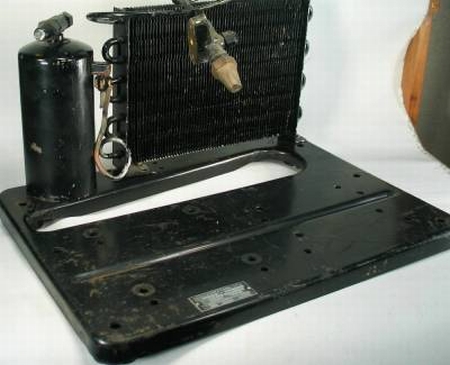Refrigerating and Air Conditioning Condensers and Receivers – Commercial
An all steel, mid 20th century, forced air, refrigerant condenser and receiver assembly, representing a world change and an epic period of transition in the engineering design and construction of refrigeration machines, making possible a new range of offerings by Canadian grocers, bakeries and restaurateurs. It was engineered for a new generation of non-noxious, non-corrosive refrigerants, the chlorinated hydrocarbons, by a new generation of equipment manufacturers, Chieftain, Tecumseh Products, 1951.
Technical Significance:
By the 1940’s times had changed and changed greatly, as a result of the introduction of hydrocarbon refrigerants, largely at the time, methyl chloride and Freon 12. The new refrigerants were non-noxious and non-corrosive, allowing the use of less expensive steel tubing for condensers. The thermodynamic properties of the refrigerants required less volume of liquid in circulation, leading to smaller refrigerant receivers. The design of pressure vessels was also better understood allowing for safe, lighter weight, more economic and environmentally safe construction.By way of contrast see item 061, classification code 6.02-2, for a receiver for sulphur dioxide, in rolled steel plate, 7 inches dia, 16 inches high, weighing 25 lbs, compare, 3 inches in dia, 7 inches high, in pressed steel, weighing 3 lbs for F12, both of similar horsepower.
Hard on the heals of this epic change in the nature of refrigeration machines, based on the development of hydrocarbon refrigerants, was another engineering revolution now well on the way and gathering momentum. So called “conventional” refrigeration machines, open systems with separate motor and belt driven compressor would soon largely disappear, in FHP capacities. They would be replaced by the end of the 1950’s by “hermetic” units and compressors, in which the motor and compressor were sealed in a single enclosure, making possible yet another generation of lighter weight, more efficient refrigeration machines [see item 039, classification group 4.01-10]


